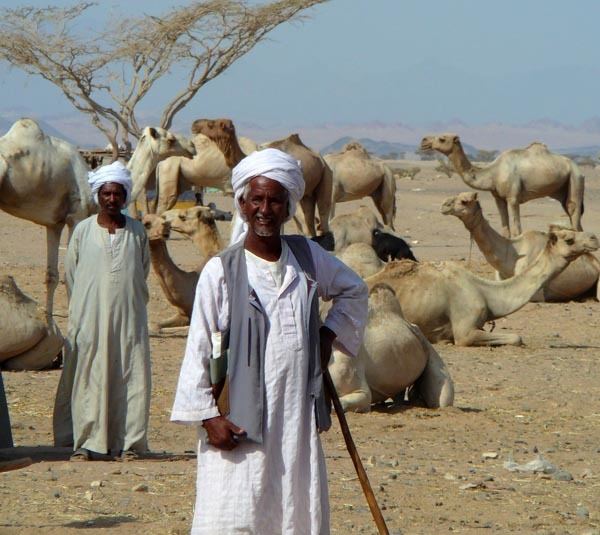 | ||
The Beja people (Arabic: البجا) are an ethnic group inhabiting Sudan, as well as parts of Eritrea, Egypt, and the Eastern Desert. They total around 1,237,000 individuals. The Beja speak the Beja language as a mother tongue, which belongs to the Cushitic branch of the Afro-Asiatic family.
Contents
History
The Beja are traditionally Cushitic-speaking pastoral nomads native to the territory in the Hala'ib Triangle, the extreme northeast of the Sudan. During the first century AD, a Beja dynasty captured Meroë and ruled the kingdom of Kush. They were partially Christianized in the 6th century, and the southern Beja were part of the Kingdom of Aksum in the early medieval period. The Beja were Islamized beginning in the 15th century. The now-Islamic Beja participated in the further Muslim conquest of Sudan, expanding southward. The Hadendoa Beja by the 18th century dominated much of eastern Sudan. In the Mahdist War of the 1880s to 1890s, the Beja fought on both sides, the Hadendoa siding with the rebels while the Bisharin and Amarar tribes sided with the British.
The Beja Congress was formed in 1952 with the aim of pursuing regional autonomy against the government in Khartoum. Frustrated by the lack of progress, the Beja Congress joined the insurgent National Democratic Alliance in the 1990s. The Beja Congress effectively controlled a part of eastern Sudan centered on Garoura and Hamshkoraib. The Beja Congress sabotaged the oil pipeline to Port Sudan several times during 1999 and 2000. In 2003, they rejected the peace deal arranged between the Sudanese government and the Sudan People's Liberation Army, and allied with the rebel movement of the Darfur region, the Sudan Liberation Movement/Army, in January 2004. A peace agreement was signed with the government of Sudan in October 2006. In the general elections in April 2010, the Beja Congress did not win a single seat in the National Assembly in Khartoum. In anger over alleged election fraud and the slow implementation of the peace agreement, the Beja Congress in October 2011 withdrew from the agreement, and later announced an alliance with the Sudan Liberation Movement/Army.
Geography
The Beja people inhabit a general area between the Nile River and the Red Sea in Sudan, Eritrea and eastern Egypt known as the Eastern Desert. Most of them live in the Sudanese states of Red Sea around Port Sudan, River Nile, Al Qadarif and Kassala, as well as in Northern Red Sea, Gash-Barka, and Anseba Regions in Eritrea, and southeastern Egypt. There are smaller populations of other Beja ethnic groups further north into Egypt's Eastern Desert. Some Beja groups are nomadic. The Kharga Oasis in Egypt's Western Desert is home to a large number of Qamhat Bisharin who were displaced by the Aswan High Dam. Jebel Uweinat is revered by the Qamhat.
Names
The Beja have been named "Blemmyes" in Roman times, "Bugas" in Aksumite inscriptions in Ge'ez, and "Fuzzy Wuzzy" by Rudyard Kipling. Kipling was specifically referring to the Hadendowa, who fought the British, supporting the "Mahdi," a Sudanese leader of a rebellion against the Turkish rule administered by the British.
Language
The Beja speak the Beja language, also known as Bedawiyet or To Bedawie. It belongs to the Cushitic branch of the Afro-Asiatic family.
The French linguist Didier Morin (2001) has made an attempt to bridge the gap between Beja and another branch of Cushitic, namely Lowland East Cushitic languages and in particular Afar and Saho, the linguistic hypothesis being historically grounded on the fact that the three languages were once geographically contiguous. Most Beja speak the Beja language, however certain sub-clans do not, the Beni Amers for instance speak a variety of Tigre, while most of the Halengas speak a mix of Bedawiet and Arabic.
Although there is a marked Arabic influence, the Beja language is still widely spoken. The very fact that the highest moral and cultural values of this society are in one way or the other linked to their expression in Beja, that Beja poetry is still highly praised, and that the claims over the Beja land are only valid when expressed in Beja, are very strong social factors in favour of its preservation. True enough Arabic is considered as the language of modernity, but it is also very low in the scale of Beja cultural values as it is a means of transgressing social prohibitions. Beja is still the prestigious language for most of its speakers because it conforms to the ethical values of the community.
Subdivisions
The Bejas are divided into clans. These lineages include the Bisharin, Hedareb, Hadendowa (or Hadendoa), the Amarar (or Amar'ar), Beni-Amer, Hallenga and Hamran, some of whom are partly mixed with Bedouins in the east.
Beja society was traditionally organized into independent kingdoms. According to Al-Yaqubi, there were six such Beja polities that existed between Aswan and Massawa during the 9th century. Among these were the Kingdom of Bazin, Kingdom of Belgin, Kingdom of Jarin, Kingdom of Nagash, Kingdom of Qita'a and Kingdom of Tankish.
